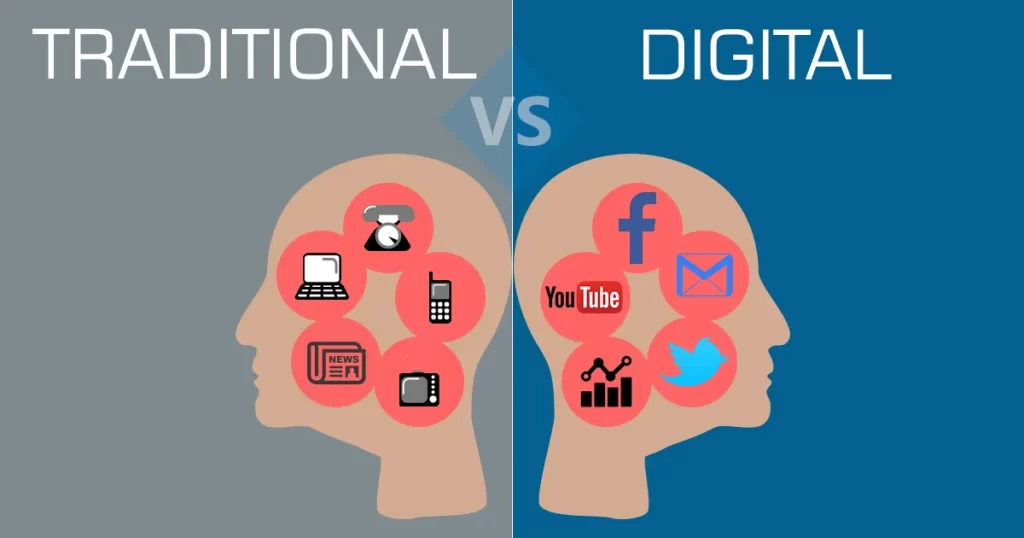
For decades, traditional marketing dominated the world of advertising. Print, radio, and television ads bombarded the masses in hopes of sticking in consumer minds. But the digital age has ushered in a revolution, transforming marketing from a shotgun blast to a laser-focused sniper shot.
Digital marketing takes advantage of the boundless opportunities technology provides to pinpoint specific audiences and deliver tailored messaging through search, social, email and more. While traditional tactics still have merit, digital reigns supreme for its efficiency, innovation and precision targeting. Read on to explore the distinct advantages, as well as challenges, that set modern digital marketing apart from old-school traditional efforts.
When executed strategically, marketers can leverage the best of both worlds, but the scales are tipped in favour of going digital. Traditional marketing relies on print, TV, radio and billboards. Digital marketing lives online – think search, social media and email. Each approach has advantages and challenges.
Traditional Marketing: A Time-Tested Technique
Methods:
Direct mail: Postcards, coupons, and information packets.
Broadcast: Television and radio commercials.
Print: Newspaper and magazine ads.
Outdoor: Billboards and fliers.
Outreach: Telephone calls and text notifications.
Why Traditional?
Traditional marketing has been the cornerstone for decades, targeting diverse audiences through familiar channels. For businesses aiming to capture the attention of an older demographic or establish a strong local presence, traditional methods still reign supreme.
Pros:
Effectiveness with Older Demographics: Audiences aged 50+ engage significantly with TV, newspapers, and radio.
Local Audience Focus: Ideal for small businesses building a local customer base.
Repetition: TV and radio commercials play repeatedly, reinforcing brand recall.
Cons:
- Costly Printing: Expenses in printing postcards may not guarantee interest.
- Delayed Results: Traditional methods take time to yield measurable data.
Digital Marketing: Marketing With Technology
Methods:
Online Content: Website, emails, content marketing.
Social Media: Posts, clickable ads, affiliate marketing.
Search: SEO strategies.
Paid Advertising: PPC campaigns.
Mobile: Targeting smartphones, laptops, and tablets.
Why Digital?
In a world driven by technology, digital marketing emerges as the go-to strategy. With over 4.95 billion active internet users globally, its reach is unparalleled. Cost-effective, trackable, and adaptable, digital marketing suits businesses aiming for a broader, global audience.
Pros:
- Instant Tracking: Real-time data on audience engagement and preferences.
- Cost-Effective: Email campaigns and social media advertising can save costs.
- Global Reach: Ideal for businesses targeting a widespread audience.
Cons:
- Ad Blockers: Some users block or skip digital ads.
- Rapid Evolution: Strategies require continual evaluation due to evolving trends.
Comparing Traditions: Traditional vs. Digital Marketing
| Criteria | Traditional Marketing | Digital Marketing |
|---|---|---|
| Audience Reach | Local and Older Demographic | Global and Diverse |
| Cost Effectiveness | Expensive Printing, Limited Reach | Cost-Effective, Wide Reach |
| Tracking and Analytics | Limited Data, Delayed Insights | Real-time Data, In-depth Analytics |
| Ad Interactivity | Repetitive but Skippable | Clickable, Engaging, Interactive |
| Ad Longevity | Repeated Airings | Short-lived, Dependent on Payments |
| Targeting Precision | Broad and Generic | Niche and Targeted |
| Response Time | Weeks or Months | Real-time Engagement |
The age-old question persists: Traditional or Digital? The answer lies in understanding your business, audience, and goals.
Digital Dominance: For cost-effectiveness, instant tracking, and global outreach, digital marketing is your virtuoso.
Traditional Tenacity: If targeting an older demographic or building a robust local presence, the traditional symphony still holds its charm.
